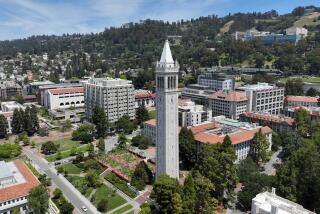CAMPUS CORRESPONDENCE : Latinos Face Uphill Fight for College Dreams
- Share via
FRESNO — A Superior Court judge has made the American dream almost prohibitively expensive for poor undocumented students in California. A college education is the single most important factor in ending a life of poverty. To deny undocumented students this route to self-betterment is to seal their fate in an underclass while dangling the promise of escape before their eyes.
Earlier this month, Robert H. O’Brien ruled that the California State University system--as well as the University of California and community colleges--must charge undocumented students non-resident tuition. His decision raises the annual tuition for undocumented students in the Cal State system to more than $7,000. They currently pay $1,308.
Proponents claim that the decision will save millions of tax dollars, a projection based on an estimated 10,000 undocumented Cal State students. State university officials say affected students probably won’t exceed 800. But debates over the true number of such students attending classes masks far more serious issues.
Supporters of tougher immigration restrictions generally make two arguments. One, that it is unfair to ask taxpayers to pay for the education of undocumented students. Truth is that most of these students have lived in California most of their lives--which means they have paid taxes of one kind or another. Why, then, deny them benefits they help pay for?
Furthermore, educating undocumented students to become more productive workers lessens the tax burden on the middle class in the long run. An uneducated, or undereducated, underclass merely drains governmental resources.
The second argument is that undocumented students are occupying class seats that otherwise would go to legal residents. This is partly true, but it should also be noted that the students sitting in those seats are qualified to be there. They have the potential to succeed and contribute to the system.
In any case, undocumented students have a right every bit as comparable to that of citizens to receive an education, because previous generations of Latino immigrants helped build this country, too. In the last 50 years, for example, agriculture in the San Joaquin Valley has thrived, the result, in large part, of the back-breaking work of immigrants.
A question remains: Will the residency status of all 361,000 Cal State students be verified? Or, will documentation be required only for those whose last names are Garcia, Moreno, or Martinez? Already, the escalating costs of higher education at UC and community colleges are keeping many Mexican American students out of academia. Now, they face added tuition costs and more discrimination at Cal State because of their skin color. For our generation, receiving an education has become more of a battle than a right.
California’s public universities and colleges are in financial chaos. More and more students are seeking admission as resources are diminishing. But rather than deal head-on with the need for increased funding, or finding new sources of revenue, public officials, once again, point their fingers and punish the weak and powerless for the system’s ills.
The scariest question: Where will it stop? Will illegal undocumented children be denied a publicly financed high school, junior high, or even an elementary school education? As incredible as this might sound, it may be a consequence of a worsening economy. After all, if we do not feel an obligation to undocumented immigrants as young adults, why should we be obligated to them as children?
If America can no longer deliver on its historical boast of unlimited opportunity, it should stop making promises.
More to Read
Sign up for Essential California
The most important California stories and recommendations in your inbox every morning.
You may occasionally receive promotional content from the Los Angeles Times.










